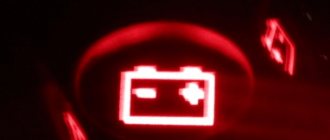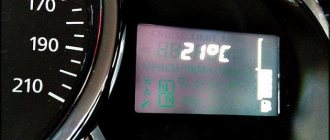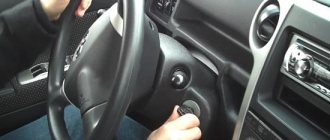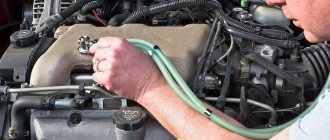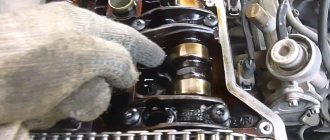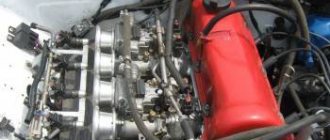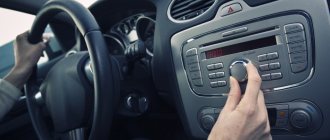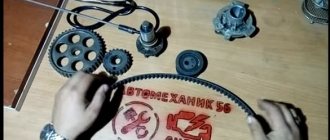Symptoms of malfunction and their elimination
You can determine whether a replacement is needed or whether you can simply tighten the power steering belt with air conditioning on the Priora 16 valves only after inspecting this component.
To do this, just open the hood and examine the belt; it is located next to the right front wheel. There are signs that indicate it's time to check the alternator belt: something whistling and squeaking from under the hood. The reasons may be the following:
- Antifreeze, oil or other working fluids have come into contact with the generator pulley or belt.
- The belt is worn out - you can tell by its appearance.
- The tension has dropped - in this case, the component must be tightened.
- The bearing in the generator is worn out.
When the belt whistles in a Priora with 16 valves, it’s time to carry out diagnostics. If there are cracks, tears or other serious damage on its surface, then replacement is required. If the generator component with hydraulic booster and air conditioning looks normal, you should check its tension; the optimal level of deflection is 6-8 mm - you need to press the component in the middle between the generator and the pulleys.
Are there visible coolant or engine oil stains on the surface? If the contamination is not significant, they can be cleaned. If the liquid has penetrated into the material, cleaning will not bring any results; replacement is needed. If the component is well tensioned and no damage or stains are visible, then you should move on to checking the bearings. They may need to be changed.
We are looking for what could be creaking in the engine compartment.
The culprit of a squeak coming from under the hood of a car may not only be the serpentine belt (drive). Although if you hear a squeaking or squeaking noise, this belt should be the prime suspect. But sometimes other elements can produce such a sound, the replacement of which can be very expensive.
Fixes
What to do if you hear a squeaking sound from the generator belt? You shouldn't change it right away. Sometimes there is a whistle, but the resource of the consumable has not yet been exhausted and it can be further used. Therefore, if extraneous sounds occur, you should inspect the belt drive and find out where the squeak comes from. To diagnose, open the hood and inspect the strap for:
- integrity of the part;
- degree of wear;
- presence of traces of working fluids on the surface;
- displacement of the pulley line, they must be strictly on the same line;
- degree of tension of the product.
Replacement should be done if the surface is worn out, there are cracks, assemblies, or frayed edges. If traces of oil, coolant or other contaminants are found, you can try cleaning the surface. Contamination prevents the product from stretching and moving evenly. If they cannot be removed, the consumable must be replaced.
The cause of generator transmission may be wear of the bearing in the tension roller or generator. To diagnose the serviceability of the tension roller, you need to dismantle it and check for defects and play. If any malfunctions are found, parts must be replaced.
The following factors influence the service life of components:
- terms of Use;
- driver's driving style;
- degree of load;
- product quality;
- correct installation.
The most common cause of whistling is poor belt tension. To check it, you need to press the product between the generator and crankshaft pulleys somewhere near the middle.
The deflection should be in the range from 6 to 8 mm. If the tension is not correct, it needs to be adjusted. If the tension is poor, the unit does not produce a full charge. To tension you need to do the following:
After the tension adjustment procedure, you need to check the operation of the unit. Before starting the engine, you need to turn on several devices powered by the generator, for example, a heater, air conditioning, and high beams. If everything is in order, then there is no whistle and the charging level is at the proper level.
To improve the operation of the belt drive, you can lubricate both surfaces of the rubber product with special liquids, for example, Hi-Gear and VeryLube conditioners. With their help you can also get rid of squeaking, but they give temporary results. Regular use of conditioners extends the service life of belts by 1.5-2 times.
The whistling of the alternator belt when the engine is cold is a common occurrence when operating cars even with low mileage.
Why it occurs, how dangerous it is, how to eliminate it without replacing the belt and tensioner itself, how to lubricate it so that it doesn’t whistle, we’ll look into this article.
Lubricants
To lubricate the alternator belt, use only approved fluids.
Below are several types of them:
- LIQUI MOLY KEILRIEMEN-SPRAY is a product for treating V-belt and poly-V-belt drives. The manufacturer claims that this spray increases elasticity, improves traction properties and reduces the likelihood of slipping, protects rubber from negative influences, increasing service life, increases the overall efficiency of flexible transmission, and eliminates squeaks.
- HI-GEAR BELT DRESSING – spray conditioner for drive belts. The product allows you to improve the adhesion properties of flexible gears, increases their service life by 1.5-2 times, protects against drying out and cracks, and reduces noise.
- VERYLUB is a spray product designed to care for belt drives. The liquid cleans working surfaces well from dirt, eliminates slippage, and protects from negative influences.
The above are some of the most common means for lubricating the generator drive, but there are many other options on the auto chemical market:
- Weicon;
- LOCTITE 8005;
- Forch P325;
- Gunk M206;
- Permatex PR-80073;
- ABRO;
- PITON
- Wurth.
All of these products are inexpensive, but can really help eliminate unpleasant sound.
Silicone lubricant in the form of a spray for treating rubber elements and the Hi-Gear conditioner have proven themselves to be effective.
The use of these means increases the elasticity and “sticking” of the drive to the pulleys.
But the use of WD-40 for these purposes is not recommended. This spray contains petroleum products that can have a negative effect on rubber and lead to its rapid aging.
This treatment can really help eliminate whistles under the hood, but only temporarily, and after a certain period they will return again. Therefore, only replacing the alternator belt will help you get rid of third-party sounds for a long time.
Possible consequences and breakdowns
Knowing the causes of the whistle, it is easy to predict the consequences and malfunctions that may result from ignoring the problem:
- the tape may fly off the shafts;
- belt rupture;
- failure of the power steering and generator.
Whistle when accelerating. Causes of a whistling sound when you press the gas
Please note that you can drive with a torn or missing alternator belt, but not for long. The battery discharges several times faster due to the generator not working, the power steering turns off - turning the steering wheel becomes much harder
Therefore, if it is not possible to fix the malfunction yourself, we recommend not to take risks and immediately, after a breakdown occurs, go to the nearest car service center to install a new belt.
For the engine itself, a break or collapse of the generator belt is not a critical failure. Since its main function is to spin up the generator, stopping rotation can lead to the cessation of its operation. This will increase battery consumption. In addition, the air conditioning and power steering may stop working, because... the generator belt also transmits rotation to their pulleys.
Belts
Second on the list of suspects were the timing belts and attachments, as well as the drive bearings of these equipment. Bearings do not last forever, and when they wear out, they often begin to make abnormal sounds. The belts lose their tension and begin to slip, which is why they also begin to “sing.” We opened the hood, listened to the engine running at idle, and found no extra noise. The whistle and jammed gas pedal did not turn on, so the car owner was asked to drive the car to a decent car service center. Professional mechanics assessed the current state of the drives, but this examination did not add clarity to the situation. Everything, from the point of view of specialists, is normal, all engine systems are functioning as expected.
What else can knock, make noise or whistle in the engine after starting?
As you can see, there are quite a lot of reasons for the appearance of knocks and noises. It should be added that when starting a cold engine, especially in winter, increased noise and chirping can be produced by the injection nozzles themselves on units with a pressure fuel injection system.
In some cases, this does not indicate any malfunction, since after a slight warm-up the noise intensity decreases or the extraneous sound completely disappears. A knock can also occur at the moment of starting in the cold due to heavily hardened ICE cushions (the engine is conditionally driven when the starter rotates slightly forward, and after starting it “bounces” back).
You should also not forget about the air conditioning compressor, especially if the engine is started in parallel with the air conditioning turned on or the climate control is activated immediately after starting. The compressor drive or the compressor itself is often the cause of extraneous noise.
The appearance of unnecessary sounds can also be associated with faulty gearboxes or clutch elements. For example, a hum after starting the engine may well come from a release bearing. It should also be taken into account that on many cars the gearbox is located directly in the engine compartment near the internal combustion engine. If it is the transmission that is humming, then this noise needs to be differentiated separately, since the engine and attachments in this case do not require additional diagnostics.
Source
How to eliminate a whistling alternator belt
You can get rid of the generator belt whistling by eliminating the reasons that cause it to slip on the pulleys.
If there are signs of belt slipping, accompanied by an unpleasant whistle, we suggest eliminating it in the following order:
- Stop the engine, open and secure the hood to prevent it from closing spontaneously;
- Carefully inspect the alternator belt without removing it from the car. There should be no tears, protruding threads or other visible damage on its surface. If they are detected, the belt must be replaced with a new one.
- Both the inner and outer sides of the belt must be dry and clean, without traces of dirt, oil and other vehicle technical fluids. The same applies to pulleys.
- Check the degree of belt tension - in most cases, the cause of a whistle from under the hood is precisely the weak tension of the generator belt. We wrote about how to properly check the tension level of the alternator belt here.
For information on the optimal degree of tension of your car's alternator belt, refer to its operating instructions.
- If necessary, adjust the belt tension. A good video instruction for adjusting the alternator belt is at the bottom of this page.
- If all of the above did not help and the alternator belt continues to squeak obnoxiously, then with the engine running and good lighting, carefully inspect the line of pulleys for alignment.
An indirect sign of pulley misalignment is the poly V-belt jumping from track to track and sliding off the pulley.
Pay attention to the linearity of rotation of the pulleys - if any pulley rotates in a figure eight, it will tear and throw off the belt. Most often, pulleys with a rubber damper behave this way, which over time loses elasticity and ceases to perform its functions.
And so, if the generator belt has not stopped whistling, but it is intact, clean, well tensioned, and the pulleys rotate smoothly and smoothly, then you can try to correct the situation using another method:
- Remove the alternator belt and carefully inspect it again for damage and dirt. If the belt is intact, then you need to clean its surface from the inside and outside (you can use gasoline or kerosene); if damage is found, buy a new belt.
- With the generator belt removed, thoroughly clean the pulleys from dirt and dust. This is best done with a wire brush. You can also use gasoline or kerosene.
- Place a clean belt on the clean pulleys and adjust its tension. After this, the whistling of the alternator belt should disappear.
If all of the above did not help and the belt whistle has not gone away, then the problem lies either in the quality of the belt itself or in the equipment that is driven by it: tension rollers, generator, power steering pump, air conditioning compressor, etc. Perhaps the grease in the bearings has simply thickened or they have failed, or perhaps the reason is much more serious, so in this case it would be better to seek help from a car service specialist.
You can try to temporarily eliminate the whistling noise using special auto chemicals, so-called conditioner-tensioners for drive belts. This, of course, will not solve the problem, but the whistling will disappear for a while.
Belt drive and its features
A flexible belt for transmitting torque to power unit attachments has become widespread for a number of reasons.
The product itself is quite flexible and durable, which allows it to be placed between many elements arranged in different orders. This type of power transmission is characterized by quiet operation, low cost and a fairly long service life.
But it was not without its drawbacks. This drive requires the correct arrangement of the elements to which it transmits force; it is quite sensitive to aggressive influences and the quality of the pulley surfaces and their distortions (if installed incorrectly).
If at least one of the conditions is violated even slightly, the belt immediately signals this with a loud and unpleasant whistle (squeal) or squeaks.
The forces here are transmitted due to friction forces, and to ensure maximum traction torque, not only a certain degree of tension is required (which ensures adhesion to surfaces), but also minimal resistance to the transmission of moments.
Due to wear and damage, friction occurs on the pulleys of the units and on the belt, which makes it difficult for the moving parts to rotate, which in turn affects the transmitting torque.
Due to the large opposing force, the belt begins to slip along the surface of the pulley, which is accompanied by unpleasant sound effects.
Therefore, if the generator belt whistles, you should not immediately change it, but you should first establish the cause of the sound, and there are many of them.
Why does the alternator belt whistle?
What are the causes of a whistling alternator belt? Typically, the whistle starts when the engine is cold or in wet weather - when the engine has just been started and other energy consumers have also turned on. It also starts whistling when you press the gas pedal - and after a while the unpleasant sound disappears.
In the cold
The main reason is moisture ingress. Fortunately, this problem is easy to fix. The belt drive is not protected by casings - in the absence of protection for the engine crankcase, water from puddles gets on it. The whistle may appear even after the power unit has warmed up, but in this case it will soon disappear.
The appearance of a whistle can be explained by insufficient tension of the belt drive or a violation of its structure. In addition, working fluid may get on the consumable, and this can lead to more serious consequences - it may simply fly off. Contact with synthetic ATF oil is especially dangerous. The ingress of conventional motor oil leads to stretching of the consumable and, as a result, to the appearance of unpleasant sounds.
Check the tension rollers, as over time they begin to jam. The belt may not move parallel to the pulley, resulting in friction with the rollers. The unpleasant sound will be heard constantly. This will lead to severe wear on the belt drive and may cause it to break. Urgently take the car to the service station!
The freewheel may become stuck. It is usually attached to the generator armature; its purpose is to reduce the load on the belt. The power unit functions unevenly - there are moments of “splash” when the fuel burns out in the cylinders, and moments of attenuation when gas begins to be removed. This negatively affects the belt if the crankshaft and the generator armature are in a rigid connection. So the alternator belt whistles on cars with clutches - this happens almost all the time.
You also need to check the clutch if you feel the canvas twitching.
The pulleys of the pumps, crankshaft and generator gradually wear out. For example, if a small pulley on a generator wears out and a large pulley on the crankshaft wears out, this will put excessive stress on the small element. Typically, pulleys are made of aluminum, which is by no means a hard material. The teeth wear out quickly and it starts to whistle. The track on the pulley itself can also be damaged - for example, crumpled after an impact. Pebbles or dirt get into the pulleys. This can easily be avoided by simply cleaning them from below with a brush. The whistle may disappear, or it may remain if the pebbles have managed to damage the surface of the teeth.
Stretching a belt drive is a natural process. To correct the situation, just tighten the connection. You shouldn't do too much lifting - a few centimeters are enough. But if the belt has cracks, chips or other signs of obvious wear, it must be replaced.
Let us summarize the reasons for the appearance of unpleasant sounds:
- ingress of moisture or working fluids;
- jamming of the tensioner or overrunning clutch;
- pulley damage;
- pollution;
- problems with tension;
- drive wear or installation of low-quality consumables.
After replacement
If the new alternator belt squeals, the problem may be that the pulley groove is dirty with grease. The lubricant will inevitably fall on the belt, which will lead to a sliding effect. The belt drive will not be able to adhere properly to the surface, resulting in an unpleasant sound.
When installing the gear, it must be tightened firmly. A poorly tensioned drive will certainly make noise during acceleration. Perhaps you changed the pulleys and aligned them incorrectly - but they must be located on the same line, since even a slight deviation leads to the appearance of extraneous noise. Sounds also occur when the bearing wears out. Therefore, when changing the drive, be sure to look at the condition of this part.
The belt drive should not be too rigid, otherwise it will not be able to transmit sufficient rotation. A rigid belt manifests itself at low temperatures, because frost causes it to harden and shrink even more. But in this case, unpleasant sounds are heard only until the engine warms up.
The main causes of whistling
Tension force
Friction force is the main indicator in a flexible transmission. Weak or excessive tension has the same negative effect on adhesion properties. If the belt “sags” due to insufficient traction, it will slip, making a whistling sound.
As for the constriction, in this case the torque set by the crankshaft will prevail over the frictional force, causing loss of adhesion and slippage.
But it often happens that after additional tension, the sound does not go away; on the contrary, it may even intensify. And in this case, the problem is clearly different.
Drive wear
The second of the main reasons for belt whistling lies in the wear of the product. Delamination, cracks and chipped areas affect the tightness of the contact of the working surface of the drive to the pulleys, which is why slipping occurs.
The flexible transmission operates with large and variable loads, and the element itself is made of rubber, and although it is reinforced with strong threads, over time it stretches, wears out the working surfaces, breaks the threads, etc.
In addition, the material itself is damaged by environmental influences, which leads to aging and delamination of the rubber.
The average belt life on many cars is about 60 thousand km, but this depends on the operating conditions.
The ingress of technical fluids (primarily oil) also affects the friction between the working surfaces.
In addition to these problems, the drive may squeal for other reasons.
The sound is heard when starting from cold. Most often this happens due to poor-quality belt material or its natural wear and tear - “aging”.
For normal force transmission, a flexible drive must have good elasticity. But if hard rubber was used for its manufacture, then due to excessive hardness it will not properly “stick” to the surface of the pulleys, but will slip.
The same result is achieved by the “aging” of rubber; it becomes “tanned”, losing elasticity.
The reason may also lie in the bearings of the units that the belt drives, especially at subzero temperatures.
This happens because the grease in the bearings hardens due to frost, which increases the rotational resistance, causing the belt to slip along the pulley.
The squealing appears when a load is placed on the on-board network or when additional equipment (air conditioning) is turned on.
The reason lies in the same poor-quality manufacturing material, loss of elasticity, and deterioration of working surfaces.
If the problem appears only when a particular piece of equipment is turned on, this indicates a faulty bearing in that unit.
Contamination of the working surfaces of the pulleys
One of the conditions for the normal functioning of the drive is the cleanliness and quality of the surfaces with which it comes into contact. Dust and dirt falling on the surfaces of the pulleys act as an abrasive, increasing the wear rate of the working surface, and at the same time reducing the adhesion properties.
Scuffs, scratches and wear on the pulleys have the same negative impact. But the greatest harm comes from oil-based technical fluids coming into contact with pulleys or drives.
They greatly reduce friction forces, allowing the belt to slip over the surfaces of the pulleys. Also, rubber is very sensitive to such substances and because of them it “ages” and breaks down faster.
Therefore, it is important to periodically clean the engine and its attachments, and also ensure that there are no leaks of working fluids, and if they do occur, quickly eliminate them.
Incorrect placement of attachments
For normal force transmission, it is necessary that all pulleys are on the same line and strictly parallel to each other.
A slight misalignment of at least one of them or a protrusion forward relative to the others will negatively affect the contact patch of the belt with the surface, which will reduce the adhesion between them and lead to slippage.
Therefore, you should periodically check the reliability of fastening of all mounted units and the condition of their bearings.
Bearings of mounted units
Support bearings prevent axial displacements and ensure alignment of moving parts of equipment - shafts and rotors, reduce friction in units, so their condition directly affects the drive.
Their severe wear leads to the appearance of axial and radial displacements of the shafts (this is where the distortions of the pulleys and their protrusions relative to others come from); the bearings themselves can jam, creating additional counteracting force.
In addition, it is often they who make the squeal, but in tonality this sound is very similar to the whistling of a belt.
Therefore, when looking for the cause of extraneous sound, you should definitely check the condition of the bearings of the attachments.
Pulleys, shafts and rotors
During operation, not only the belt wears out, but also the pulleys themselves, albeit less intensely. But over time, traces of wear and tear appear on their working surfaces, which can affect the adhesion properties of the surfaces. The same situation applies to shafts and rotors.
In places where they contact the bearings, wear gradually appears, which causes backlash, and even the installation of new support elements does not solve the problem.
Changing the Physical Characteristics of the Drive
Negative environmental influences lead to rubber losing its elasticity (it “gets stiff”), which causes the friction force to decrease. At the same time, the belt itself may visually look like new and completely serviceable.
The most basic reasons for the appearance of whistling are listed above, but in reality there are more of them.
Why does the timing belt make noise when cold?
Many car owners are faced with such a problem as a sharp whistle (squealing) from under the hood when the engine is running. It can appear both when the engine is “cold” and when the engine is fully warmed up, under different loads. Usually everyone starts to blame the occurrence of such a problem on the generator and its belt.
At the same time, they do not pay attention to the second belt drive - the gas distribution mechanism
But the appearance of a whistle in it is a more dangerous problem than in the drive belt of attachments. In general, it is not difficult to find out which drive has problems. It is enough to remove the alternator belt from the car and start the engine. A squeak that disappears or continues to sound will let you know where to look for the cause. If there is a squeal even with the belt removed, there is definitely a problem with the timing drive.
To more accurately identify what exactly caused it without any disassembly, you can use a technical phonendoscope. Using it, you can identify the area where the sound occurs, which will allow you to immediately determine which of the elements is faulty after sampling.
There are not so many main reasons for timing belt whistling:
- The belt itself can make sounds. If it is extremely worn, made of low-quality material, and not tensioned enough, then passing through the rollers (and it contacts them with a smooth surface), it will slip, making unpleasant sounds;
- The rollers may squeal due to the belt being tightened;
- Technical fluids (oil, antifreeze) have come into contact with the drive. As a result, they act as swarms of lubricant, reducing friction between the surfaces of the rollers and the belt, which causes slippage;
- Bearing wear. To ensure ease of rotation of the rollers and pump, bearings are installed in their design. If these elements are extremely worn out or there is insufficient lubrication, then increased friction occurs in them, accompanied by a squealing sound;
- Carelessness in carrying out work to replace the belt, resulting in the bending of the axis of one of the rollers. This leads to the fact that the position of the roller changes slightly, and due to a slight misalignment, the friction between the drive and the tension or bypass element increases
Each of the reasons has its own characteristic features. For example, if you use a belt made of low-quality material that does not have sufficient elasticity, then in winter the rubber will “tan” after being parked in the cold. As a result of this, the drive element will be the cause of the “cold” whistle, which disappears after heating.
Causes
For older cars, a whistling sound on a cold engine meant that the water pump drive or the pump itself had become unusable. For newer cars, there may be several reasons for this effect.
It is worth noting that this malfunction is related to the mechanics of the engine, and there is no need to go into the electronic control unit. Therefore, let’s consider where a motorist needs to look for a fault if he wants to repair the vehicle with his own hands:
- Drive belts.
- Rollers.
- Water pump.
- Generator.
Why does the belt of additional units whistle when starting the engine when cold: probable reasons
A serviceable belt drive operates silently. The appearance of extraneous noise is the result of the belt slipping along the pulleys. As a result of the friction of the wedges on the metal, not only acoustic discomfort is observed, but also increased wear of the fabric-rubber product. It is worth noting that a defective or unlubricated tensioner roller does not make a whistle - it rustles while the engine is warming up or throughout its operation.
How to make sure
It’s not difficult to guess what to do when the alternator belt squeaks or what to do when it whistles - you need to check the tension. Often the belt structure is weakened due to unqualified assistance or stretching during long-term use. This is the first and simple rule when such a malfunction is detected. By the way, it is only available in the case of recent installation of a new product.
However, not all machines have units connected through a generator. On many cars with a timing chain drive, there may be two belts: one connects the current-generating unit and the cooling system pump to the engine. The second is a power steering pump and an air conditioning compressor with a motor.
The test method involves applying additional load to the belts by using the maximum power of the attachment. The alternator belt may squeal at idle if all electrical appliances are activated at the same time:
- Heated seats.
- Car radio.
- Heated side mirrors and rear window.
- High beam headlights.
- Cabin heater.
Diagnosis of the presence of extraneous sounds when another belt is operating consists of activating the air conditioning system while simultaneously rotating the steering wheel. The installation scheme of belt structures may be different - it all depends on the design features of the power unit.
Causal factors
Insufficient tension is not the only reason why the belt whistles when starting the engine cold or hot. A worn-out product can also produce extraneous sound: the rubber component becomes tanned in the cold. Insufficient elasticity does not allow the transmission of torques of the required magnitude.
Contamination of the poly-wedge part leads to loss of proper adhesion properties due to rapid wear. It is critical to evaluate the presence of oil stains on the working surface of the strap. Often a whistle is observed a few seconds after passing a puddle. In this case, there is no need to take any action - the product will dry out and the squealing will go away.
Grinding, knocking or whistling noise when starting the engine
The appearance of extraneous sounds in the engine compartment during or immediately after starting the engine is a reason to diagnose and check the internal combustion engine. Various deviations from the norm can occur as a result of wear of individual elements of attachments, drives, bearings, pulleys or belts. Also, one should not exclude the possibility of breakdown of the power unit itself and its components. Drivers often notice that when starting the engine when cold, a grinding noise is heard, something creaks in the engine, a whistle appears, etc.
It should be noted that usually many sounds are better heard during a cold start, although in some cases the noise does not go away even after the power unit warms up. It should also be added that in some cases the problem progresses noticeably, that is, the sound gets stronger each time or gradually. In other situations, extraneous noise may not change its tone and intensity over hundreds or even thousands of kilometers.
In this article we will talk about what kind of breakdowns can lead to noise being heard during a cold engine start, as well as how and by what additional signs you can determine the malfunction yourself.
How to eliminate a whistling sound when starting the engine
Elimination methods will depend on the immediate cause of the whistle when starting on a cold engine. This may be needed:
- Pull the belt.
- Clean the streams in the crankshaft or generator pulley.
- Replace a failed part, which could be a pump, roller, or bearing.
- Replace the suspension belt.
Since, according to statistics, the alternator belt is most often “to blame,” the diagnostics need to start with it. It is recommended to perform the appropriate check every 15...20 thousand kilometers or more often. Usually a V-belt is used for the generator.
When checking, you need to pay attention to the presence of cracks on its inner surface (ribs) when the belt bends. If cracks occur, the belt needs to be changed.
The approximate recommended mileage of a car to replace the alternator belt is about 40...50 thousand kilometers. Please note that the life of a particular belt is also affected by its tension.
If the belt tension is loose, it must be tightened. This is usually done using a corresponding roller or adjusting bolt (depending on the design of the particular car and its engine). If a tension mechanism is not provided, then in this case it is necessary to replace the stretched belt with a new one.
To determine whether a belt or roller is whistling, since the sounds they make are very similar, you can use special protective aerosols - rubber softeners. Most often, belt conditioners are used for this, less often silicone grease or the popular universal product WD-40. In particular, it is necessary to spray the specified aerosol on the outer surface of the belt. If it is worn, stretched and/or very dry, then this temporary measure will eliminate the whistling for a while.
Accordingly, if the product helped, it means that the “culprit” of the unpleasant sounds is the worn belt. If this measure does not help, then most likely the roller is to blame, in particular its drive bearing. Accordingly, additional verification needs to be performed.
When tightening an old belt or tensioning a new belt, you do not need to be very zealous and set the force to a very high level. Otherwise, the load on the generator bearing and tension roller will increase, which can lead to their rapid failure.
Some car enthusiasts, instead of replacing the specified belts (both air conditioning and alternator), use special products - rubber softeners or friction enhancers (contains rosin). However, as practice shows, such means can only be used as a temporary solution to the problem. If the belt has significant mileage, then it is better to replace it with a new one.
When checking the belt, pay attention to the grooves of the pulleys. Take the time to remove the belt and go over the HF and alternator pulleys with a wire brush and brake cleaner to wash off all the dirt
If it turns out that it is not the belt that is whistling, but the roller, then it is worth changing it. When the squeak comes from the pump bearings or the generator overrunning clutch, the part also needs to be replaced.
But if the squeak is produced by a resonating DPKV, as happens on Ladas, then it is enough to place a small gasket under it in accordance with the size of the sensor. So, cut out a small gasket from foil and install it between it and the engine housing. Depending on the size of the gap, the gasket will have three to four layers of foil. The main task of the gasket is to provide mechanical force on the sensor from top to bottom.
When performing similar work on other vehicles, the size of the gasket and its installation location may vary. To find out exactly where the gasket needs to be installed, you need to mechanically press the housing of the crankshaft position sensor with your thumb. That is, you can press from top to bottom, from bottom to top, or sideways. So, experimentally, you can find a position in which the sound disappears completely or becomes much quieter.
Alternator belt diagnostics
What else could whistle?
To understand how to eliminate a whistling alternator belt, you need to be able to accurately diagnose what exactly is making noise, under what conditions the sound appears and why.
How to find out exactly what is whistling and why?
In order to accurately find the source of the whistling (RG or tensioner), you need to turn off the engine and open the hood. Often, the wear of the belt drive, its clogging or other causes of malfunction are immediately visible visually. In addition, you can diagnose a breakdown of the RG by the duration of the whistling sound. When, when starting the engine, it whistles for a short time when it is cold, i.e., before warming up, this may not indicate wear of the part itself, but rather moisture or other liquid getting on it, clogging, or problems with tension.
If, after cleaning the pulleys and RG, as well as completely replacing the part with a new one, a whistling sound is heard even when the engine is under load and running hot, then the generator belt roller is whistling and needs to be repaired or replaced. A visual sign of a tension roller malfunction may be a more “worked out” appearance of the belt on the tension side.
Ways to eliminate whistling in a belt mechanism
Depending on the reasons considered for the appearance of an unpleasant sound from under the hood, there are several different ways to eliminate the whistling of the alternator belt.
Belt elasticity spray
In order for the generator to last as long as possible and not be disturbed by whistling, it must be periodically lubricated with a special conditioner spray or generator belt lubricant. To lubricate the RG, open the hood, turn on the engine at idle speed, and evenly spray lubricant on its inner and outer sides.
The spray quickly eliminates “squealing” and slipping of generator drive belts
When working mechanisms jam
If visual diagnostics reveal a problem with the bearing or jamming of the pulleys on which the RG is attached, then these mechanisms must be replaced. It is quite difficult to replace the crankshaft or generator pulley on your own, so if such a malfunction is detected, we recommend that you do this at the nearest car service center.
When clogged/contaminated
We remove the RG and clean its working surface with a brush from accumulated dust and dirt. We do the same with the pulleys and tensioner. Additionally, parts can be treated with alcohol or solvent.
If the belt is dirty, it must be removed and cleaned - this will help eliminate the whistling
The big problem is the pulleys
Replacing the drive belt is usually inexpensive. The belt itself is cheap. The job won't empty your pockets either. By the way, depending on the engine, there are cars that have two drive belts. In this case, you will have to pay twice as much money to replace the belts. Of course, the final cost of replacing belts will be affected by the make and model of the car. On average, prices for replacing drive belts start from 800-1000 rubles. Replacing the belt tensioner roller will also cost about 800 rubles. As you can see, this is not a problem.
See also: How to check belts and hoses in a car
The real cost for a car owner begins when it's time to replace the pulleys. The main pulley is mounted on the crankshaft. Fortunately, it wears out very rarely unless equipped with a torsional vibration damper. But if the pulley wears out, prepare a round sum, since the cost of replacing it will unpleasantly surprise you. Most often it is necessary to change the alternator pulley, power steering pump pulley and air conditioner.
Signs of alternator pulley wear
After starting the engine, sometimes the alternator belt does not creak, but after turning on the electrical equipment, a whistling or squeaking noise begins. This may be a sign of wear on the alternator pulley. It may also indicate problems with the alternator and battery. Replacing a generator pulley can cost from 2,000 to 6,000 rubles. By the way, this work already relates to rebuilding the generator. Nowadays, generators are increasingly equipped with a pulley with a vibration damper.
Signs of wear on the air conditioning compressor pulley
The same applies to the air conditioning compressor pulley, which begins to squeak when starting up. When the compressor is turned off, the squeaking noise stops.
Signs of wear on the power steering pump pulley
The power steering pump pulley is the easiest to check. To do this, turn the steering wheel all the way to one side with the engine running, making several deep turns over and over again. Naturally, this needs to be done when the car is stationary. If, when you turn the steering wheel all the way, you hear a whistling or squeaking sound, then it is quite possible that there is severe wear on the power steering pulley or the power steering pump bearing. Also, a similar sound can appear when the belt that transmits torque to the power steering wears out.
See also: What's under the hood of your car: Information for novice drivers
The rollers and tensioner may be to blame for squeaks or whistles under the hood. That’s why they always need to be replaced as a set, so that all drive components in the engine compartment serve equally. Also, when purchasing rollers and tensioners, try to purchase parts from the same manufacturer.

